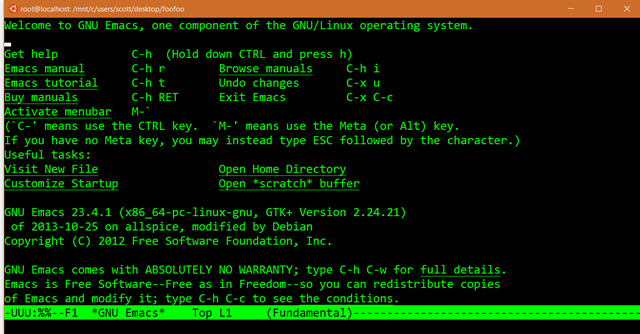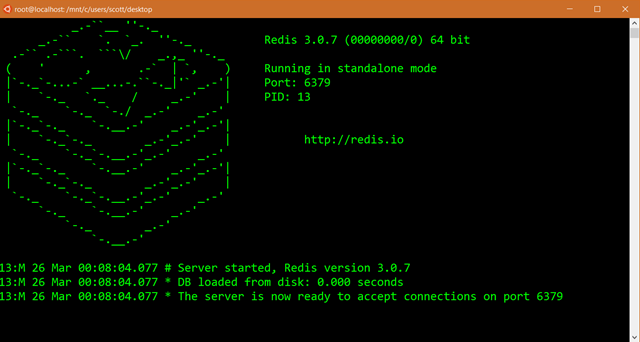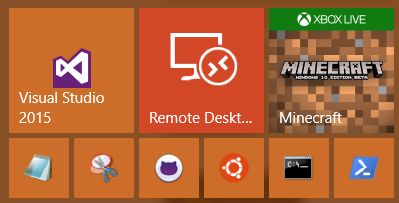On International Penguin Day, a meditative video and story about Ubuntu and Bash in Windows 10 by Scott Hanselman
- Transfer
Hello!
Scott Hanselman is a well-known Microsoft activist who writes a lot about how to use Open Source and Microsoft. Below is a translation of his latest article on the well-known Ubuntu and Bash news on Windows 10. And also, today is April 25th, entitled the globally important international penguin day, so we urge you to visit the penguins more often, and also, of course, visit our constantly An updated site about Open Source and Microsoft . If you want to be distracted on this wonderful working day, then we apply a special video, having watched that, you can learn everything about penguins.

Previously, an invitation in the form of a $ symbol for Windows users, including for me, meant "pass by."
I was looking for such an invitation

or such.

Of course, the necessary invitations were not always met. But today, on the first day of the ** BUILD ** conference, Kevin Gallo (* Kevin Gallo *) said in his report that developers will now be able to run "** Bash on Ubuntu on Windows **." This feature is included in the anniversary update of Windows 10 (coming soon). It allows you to run Linux shell scripts and Linux command-line utilities on Windows without any modifications.
If you enable the developer mode in the Windows settings, add this function and run the bash script, the system will offer to download Ubuntu on Windows from Canonical via the Windows Store:

This mechanism runs on 64-bit Windows and does not use virtual machines. Why is Windows Bash useful for developers?
Previously, when you wanted to run Bash on Windows, you could use several options.
- Cygwin - GNU command line utilities compiled for a 32-bit OS and perfectly integrated with Windows. But it is not Linux.
- HyperV and Ubuntu - launch of a separate Linux virtual machine (with allocation of X gigabytes of RAM and Y gigabytes of hard disk space) and remote connection to it (RDP, VNC, ssh).
- Docker also allows you to run a Linux container in a HyperV virtual machine
Running bash on Windows - this is exactly what was missing before. From the user's point of view, the mechanism works like Linux, since it executes real Linux binaries. Just press the Windows key and type “bash”.
After setting up, enter “apt-get update” and download several developer packages. I needed Redis and Emacs. To install emacs, I ran the apt-get install emacs23 command. Please note: these are real emacs from the Ubuntu repository.

Of course, I have no idea how to exit emacs, so I just closed the window. ;)
Please note: the mechanism is not intended to run Linux servers or server loads. This release is aimed at developers who are interested in (or who need) the use of Linux tools in the workflow, and removes this serious limitation. Here I installed ** Redis with apt-get ** and got the ability to run it in isolated mode.

I run Redis in bash and create ASP.NET applications in Visual Studio using the Redis cache. With ** Azure Redis Cache **, I will then deploy the solution to Azure - quite a common thing for me.
Take a look at how holistic my start menu now looks!

In the coming weeks, technical details will be published on the blog [http://blogs.msdn.microsoft.com/commandline†(http://blogs.msdn.microsoft.com/commandline). In addition, you are waiting for grand updates to the base console, which will improve support for console codes, ANSI, VT100 and much more. This is an early version of developer-specific features, and the team is waiting for your feedback and comments. The “Ubuntu on Windows” feature will be available to developers in one of the upcoming builds of Windows 10. Initially, some features will not work as intended, but we hope that you will be interested to get to know them and find out how Ubuntu on Windows fits into your process development!
Scott Hanselman is a well-known Microsoft activist who writes a lot about how to use Open Source and Microsoft. Below is a translation of his latest article on the well-known Ubuntu and Bash news on Windows 10. And also, today is April 25th, entitled the globally important international penguin day, so we urge you to visit the penguins more often, and also, of course, visit our constantly An updated site about Open Source and Microsoft . If you want to be distracted on this wonderful working day, then we apply a special video, having watched that, you can learn everything about penguins.

Previously, an invitation in the form of a $ symbol for Windows users, including for me, meant "pass by."
I was looking for such an invitation

or such.

Of course, the necessary invitations were not always met. But today, on the first day of the ** BUILD ** conference, Kevin Gallo (* Kevin Gallo *) said in his report that developers will now be able to run "** Bash on Ubuntu on Windows **." This feature is included in the anniversary update of Windows 10 (coming soon). It allows you to run Linux shell scripts and Linux command-line utilities on Windows without any modifications.
If you enable the developer mode in the Windows settings, add this function and run the bash script, the system will offer to download Ubuntu on Windows from Canonical via the Windows Store:

This mechanism runs on 64-bit Windows and does not use virtual machines. Why is Windows Bash useful for developers?
Previously, when you wanted to run Bash on Windows, you could use several options.
- Cygwin - GNU command line utilities compiled for a 32-bit OS and perfectly integrated with Windows. But it is not Linux.
- HyperV and Ubuntu - launch of a separate Linux virtual machine (with allocation of X gigabytes of RAM and Y gigabytes of hard disk space) and remote connection to it (RDP, VNC, ssh).
- Docker also allows you to run a Linux container in a HyperV virtual machine
Running bash on Windows - this is exactly what was missing before. From the user's point of view, the mechanism works like Linux, since it executes real Linux binaries. Just press the Windows key and type “bash”.
After setting up, enter “apt-get update” and download several developer packages. I needed Redis and Emacs. To install emacs, I ran the apt-get install emacs23 command. Please note: these are real emacs from the Ubuntu repository.

Of course, I have no idea how to exit emacs, so I just closed the window. ;)
Please note: the mechanism is not intended to run Linux servers or server loads. This release is aimed at developers who are interested in (or who need) the use of Linux tools in the workflow, and removes this serious limitation. Here I installed ** Redis with apt-get ** and got the ability to run it in isolated mode.

I run Redis in bash and create ASP.NET applications in Visual Studio using the Redis cache. With ** Azure Redis Cache **, I will then deploy the solution to Azure - quite a common thing for me.
Take a look at how holistic my start menu now looks!

In the coming weeks, technical details will be published on the blog [http://blogs.msdn.microsoft.com/commandline†(http://blogs.msdn.microsoft.com/commandline). In addition, you are waiting for grand updates to the base console, which will improve support for console codes, ANSI, VT100 and much more. This is an early version of developer-specific features, and the team is waiting for your feedback and comments. The “Ubuntu on Windows” feature will be available to developers in one of the upcoming builds of Windows 10. Initially, some features will not work as intended, but we hope that you will be interested to get to know them and find out how Ubuntu on Windows fits into your process development!
